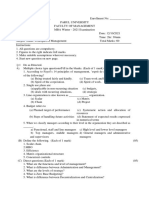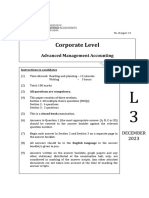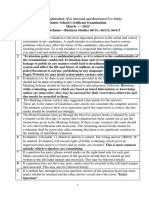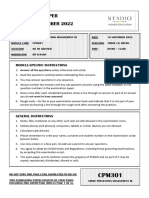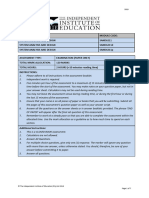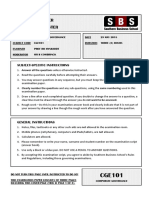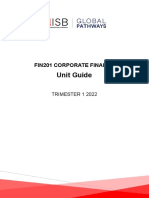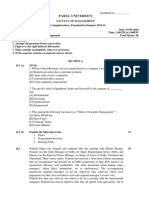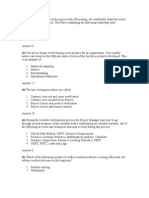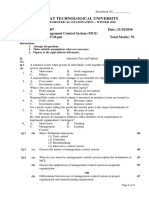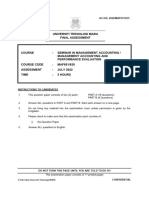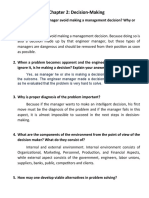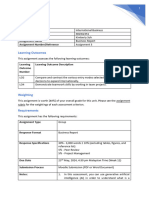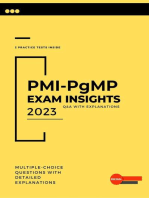Module Name: Module Code: Business Management and Entrepreneurship BUME112
Module Name: Module Code: Business Management and Entrepreneurship BUME112
Uploaded by
MohammedCopyright:
Available Formats
Module Name: Module Code: Business Management and Entrepreneurship BUME112
Module Name: Module Code: Business Management and Entrepreneurship BUME112
Uploaded by
MohammedOriginal Title
Copyright
Available Formats
Share this document
Did you find this document useful?
Is this content inappropriate?
Copyright:
Available Formats
Module Name: Module Code: Business Management and Entrepreneurship BUME112
Module Name: Module Code: Business Management and Entrepreneurship BUME112
Uploaded by
MohammedCopyright:
Available Formats
The Independent Institute of Education 2017
MODULE NAME: MODULE CODE:
BUSINESS MANAGEMENT AND ENTREPRENEURSHIP BUME112
ASSESSMENT TYPE: EXAMINATION (PAPER ONLY)
TOTAL MARK ALLOCATION: 120 MARKS
TOTAL HOURS: 2 HOURS (+10 minutes reading time)
INSTRUCTIONS:
1. Please adhere to all instructions in the assessment booklet.
2. Independent work is required.
3. Five minutes per hour of the assessment to a maximum of 15 minutes is dedicated to reading
time before the start of the assessment. You may make notes on your question paper, but not
in your answer sheet. Calculators may not be used during reading time.
4. You may not leave the assessment venue during reading time, or during the first hour or
during the last 15 minutes of the assessment.
5. Ensure that your name is on all pieces of paper or books that you will be submitting. Submit
all the pages of this assessment’s question paper as well as your answer script.
6. Answer all the questions on the answer sheets or in answer booklets provided. The phrase
‘END OF PAPER’ will appear after the final set question of this assessment.
7. Remember to work at a steady pace so that you are able to complete the assessment within
the allocated time. Use the mark allocation as a guideline as to how much time to spend on
each section.
Additional instructions:
1. This is a CLOSED BOOK assessment.
2. Calculators are not allowed.
3. For multiple-choice questions, give only one response per question. The marker will ignore
any question with more than one answer, unless otherwise stated. You should, therefore, be
sure of your answer before committing it to paper.
4. Answer all questions.
© The Independent Institute of Education (Pty) Ltd 2017
Page 1 of 9
The Independent Institute of Education 2017
Question 1 (Marks:20)
Multiple-choice questions: Select one correct answer for each of the following. In your answer
booklet, write down only the number of the question and next to it, the number of the correct
answer. E.g. 1.3 4
Q.1.1 Nearly …… of a manager’s time is spent actively exchanging information as they attend (2)
meetings, dictate letters, talk on the telephone, send and receive e-mail and reports
and so on.
(1) 20%;
(2) 50%;
(3) 80%;
(4) 100%;
(5) 25%.
Q.1.2 The greatest assets of an organisation are: (2)
(1) People;
(2) Machinery;
(3) Financials;
(4) Markets;
(5) Buildings.
Q.1.3 Ranking as a method of Performance Appraisal rates performance by: (2)
(1) systematically evaluating each employee’s job-related strengths;
(2) Evaluating employees on a series of performance dimensions along a points
scale, usually five or seven points;
(3) Using a numerical scale to measure a range of performance;
(4) Exchanging information about the employee’s strengths and developmental
needs during the interview;
(5) Comparing employees doing the same or similar work.
© The Independent Institute of Education (Pty) Ltd 2017
Page 2 of 9
The Independent Institute of Education 2017
Q.1.4 Medium-term goals are usually to be achieved within a …… period. (2)
(1) Five year;
(2) One year;
(3) Two year
(4) Three year;
(5) Ten year.
Q.1.5 Measurable means that goals must be: (2)
(1) realistic and attainable;
(2) objectively evaluated or quantified;
(3) Consistent with management perceptions and preferences;
(4) Congruent and attainable;
(5) flexible at the expense of specificity to allow for modifications.
Q.1.6 Strategic plans focus on: (2)
(1) people and action to implement the strategic plans;
(2) the entire organisation and interaction with the external environment;
(3) Single use plans and standing plans;
(4) segmentation of the market;
(5) non-recurring activities such as the refurbishment of a new office building.
Q.1.7 All of the following aspects form part of a job description except: (2)
(1) Working conditions;
(2) The job title;
(3) Summary of work;
(4) Duties to be performed;
(5) Qualifications of the applicant.
© The Independent Institute of Education (Pty) Ltd 2017
Page 3 of 9
The Independent Institute of Education 2017
Q.1.8 The term business plan is described as: (2)
(1) A set of steps taken to identify a problem and selecting the most effective
solution;
(2) The process of monitoring performance;
(3) A roadmap concerning where the business wants to go, and the tactics that will
be used to achieve its goals;
(4) The means of arranging tasks for goal attainment;
(5) An organisational structure made up of self-contained units or divisions.
Q.1.9 When a manager plays a role of decision-making he does the following except: (2)
(1) Spokesperson;
(2) Negotiator;
(3) Problem solver;
(4) Allocator of resources;
(5) Entrepreneur.
Q.1.10 In the macro-environment, technological environment is responsible for: (2)
(1) people’s lifestyles, habits, and shaping culture;
(2) Influencing the local and foreign trends and event;
(3) man-made improvements such as roads and bridges;
(4) the pace of innovation and change;
(5) government influence management.
© The Independent Institute of Education (Pty) Ltd 2017
Page 4 of 9
The Independent Institute of Education 2017
Question 2 (Marks:10)
Match the description in Column A with the correct term from Column B. In your answer booklet, write
down only the question number and, next to it, the letter of the correct answer.
Column A Column B
Q.2.1 Shows relationship of components in a single a. Gross profit margin, operating
financial statement. profit margin, net profit margin.
Q.2.2 The raw, unanalysed numbers and facts about b. Information
conditions or events from which we draw
information.
Q.2.3 Percentage analysis of the increases and c. Net working capital, current ratio,
decreases in the items on comparative financial quick ratio.
statement.
Q.2.4 Allow one to communicate with your computer. d. System software.
Q.2.5 Consists of electronic components that executes e. Application software,
and interpret the computer program’s
instructions.
Q.2.6 The processed data that is relevant to a f. Vertical financial statement
manager. analysis.
Q.2.7 Profitability Analysis g. Systems analysis.
Q.2.8 Manages the operations of the computer. h Horizontal financial statement
analysis
Q.2.9 Performs specific data processing or text- i Central processing unit (CPU),
processing functions such as a word-processing
package.
Q.2.10 Liquidity Analysis j Data
k Information system
l Input devices,
© The Independent Institute of Education (Pty) Ltd 2017
Page 5 of 9
The Independent Institute of Education 2017
Question 3 (Marks:10)
Franchising is one of the methods used to enter the business world.
Q.3.1 Explain what is meant by the term franchise. (2)
Q.3.2 Outline any two advantages and two disadvantages of franchising. (8)
Question 4 (Marks:10)
Discuss the characteristics needed by managers for effective decision making.
Question 5 (Marks:10)
The timing and scope of the change are important because most organisational change efforts run
into some form of resistance from employees.
Identify and describe the reasons why people resist change.
Question 6 (Marks:13)
Control is the final step in the management process and the term “control” implies that the
behaviour of individuals can be influenced in the course of activities and events.
Q.6.1 Explain the important role played by control in any organisation. (5)
Q.6.2 Outline the main steps in the control process. (8)
Question 7 (Marks:10)
Effective and efficient processing of information is crucial in an organisation. This can be achieved
by creating organisations like ‘Matrix’ or ‘Network’ organisations.
Describe how a Network organisation works and highlight its benefits to the Network organisation
manager.
© The Independent Institute of Education (Pty) Ltd 2017
Page 6 of 9
The Independent Institute of Education 2017
Question 8 (Marks:12)
Read the case study below and answer the questions that follow:
Williams & Company – Macro environment
Williams & Company (known as WC) is a South African based management consulting firm. WC is a
medium sized business in existence for 20 years. The firm provides consulting services to
corporations including business optimisation consulting, project management, productivity
improvement training, and improvement measurement systems. In the last decade the business
environment, locally and internationally, shifted drastically. WC had to contend with the following
changes:
A world-wide economic down-turn which resulted in large businesses going down. The
financial services industry took serious strain as lending practices were confronted by
governments and regulatory bodies. This lead to the institution of new compliance,
governance and risk management policies.
Certain countries headed towards bankruptcy which required international intervention and
assistance provided by the world-bank.
The market generally, across industry-sectors, became much more cost sensitive. A trend
emerged where the start-up rate of new small and medium-sized enterprises (SME
businesses) diminished. Liquidation in SME sector increased at an alarming rate.
Due to corporate restructurings and down-sizing, and greater risks for entrepreneurs in the
SME sector, retrenchments became the order of the day, and new employment creation
stagnated.
The management consulting industry was not unaffected. Business models changed, and
consultancies merged and formed joint ventures to achieve greater market share and drive
competition out. Consultancies also expanded into new markets particularly in Africa and
Asia in response to limited growth opportunities in existing markets. Utilisation of new
technologies particularly in information management became a priority in order to create
more cost-effective structures, and to gain advantage in greater access to market
intelligence.
In the South African context, government initiated a more aggressive push towards Broad-
Based Black Economic Empowerment (BBBEE). This changed the ownership profile of
businesses, as well as procurement and supply policies and practices. The drive towards
employment equity became sharper, and labour legislation became much stricter concerning
© The Independent Institute of Education (Pty) Ltd 2017
Page 7 of 9
The Independent Institute of Education 2017
resourcing and employee relations. Furthermore, employee development became regulated
in terms of skills development legislation. The financial services industry became more
regulated as far as credit supply was concerned.
Moreover, substantial increases in fuel prices in South Africa, driven by the oil price, and
energy supply capacity challenges and the consequent increase in costing of electricity, had
a major inflationary impact across the economy.
Instability in commodity prices and worsening industrial relations strained the resource
sector, a major contributor to the South African economy.
WC launched several initiatives to respond to the changes in the business environment. A major
strategic movement was to form a business partnership with a global consultancy to ensure access
into Africa and to achieve market consolidation.
Q.8.1 Identify macro-economic factors that drove change at W&C and motivate your (12)
answer with the quote from the case.
Question 9 (Marks:15)
Organisations use different types of training methods to improve the performance of their
employees.
Q.9.1 Discuss what training for the job does to employees in an organisation. (5)
Each group has a certain structure that determines how individual group members and the group
as a whole function. Briefly explain the following five factors that influence group structures.
Q.9.2 Leadership; (10)
Norms;
Cohesiveness;
Status hierarchy; and
Diversity.
© The Independent Institute of Education (Pty) Ltd 2017
Page 8 of 9
The Independent Institute of Education 2017
Question 10 (Marks:10)
Each and every organisation need to have a plan. A plan enables an organisation to get things done
through knowing what needs to be done or how to do them.
Explain the importance of planning for an enterprise.
END OF PAPER
© The Independent Institute of Education (Pty) Ltd 2017
Page 9 of 9
You might also like
- OCR GCSE 9-1 Business, Third EditionDocument329 pagesOCR GCSE 9-1 Business, Third EditionAnya Johal85% (13)
- Fan Static Pressure CalculationsDocument2 pagesFan Static Pressure Calculationsscribd9919088% (8)
- PGDIPM - Business Research - Nov 2020 Take Home AssessmentDocument2 pagesPGDIPM - Business Research - Nov 2020 Take Home AssessmentSITHOKOZILE0% (1)
- Emcee Script JsDocument10 pagesEmcee Script JsRon Styx88% (24)
- German Panzer Group Von Kleist 10 May 1940Document4 pagesGerman Panzer Group Von Kleist 10 May 1940Paul McHughNo ratings yet
- Module Name: Module Code: Business Management and Entrepreneurship BUME112Document7 pagesModule Name: Module Code: Business Management and Entrepreneurship BUME112MohammedNo ratings yet
- Business Information Systems BUIS112 Examination (Paper Only) 120 MARKS 2 HOURS (+10 Minutes Reading Time)Document6 pagesBusiness Information Systems BUIS112 Examination (Paper Only) 120 MARKS 2 HOURS (+10 Minutes Reading Time)MohammedNo ratings yet
- University of Cebu: PlanningDocument16 pagesUniversity of Cebu: PlanningInbalidNo ratings yet
- There Are Seven (7) Pages of Questions, Including ThisDocument7 pagesThere Are Seven (7) Pages of Questions, Including ThisAmyzah NafisahNo ratings yet
- MGT106 Tutorial Sem2 2020Document34 pagesMGT106 Tutorial Sem2 2020limnkNo ratings yet
- When We Classify Managers According To Their Level in The Organization They Are Described AsDocument2 pagesWhen We Classify Managers According To Their Level in The Organization They Are Described AsAnkit YadavNo ratings yet
- 2023 - 12 - 11 - 147 - CL3 - Advanced Management Accounting - December 2023 - EnglishDocument14 pages2023 - 12 - 11 - 147 - CL3 - Advanced Management Accounting - December 2023 - EnglishfcNo ratings yet
- Parul University: A) C) B) D)Document2 pagesParul University: A) C) B) D)Ankit YadavNo ratings yet
- Business Studies (054) Set 66 C 2 Marking Scheme Comptt 2020Document38 pagesBusiness Studies (054) Set 66 C 2 Marking Scheme Comptt 2020Mayank RajNo ratings yet
- HR Diploma February 2024 FISADocument11 pagesHR Diploma February 2024 FISAnooshieshaikhNo ratings yet
- Business Studies (054) Set 66 C 1 Marking Scheme Comptt 2020Document41 pagesBusiness Studies (054) Set 66 C 1 Marking Scheme Comptt 2020Mayank RajNo ratings yet
- PMNotes Lecture3Document60 pagesPMNotes Lecture3Vishwajit NaikNo ratings yet
- PMP Mock Exams Set1Document15 pagesPMP Mock Exams Set1Bhushan PAwar100% (1)
- Businesss Analysis StudentDocument24 pagesBusinesss Analysis StudentThịnh Đỗ QuốcNo ratings yet
- M3 Cats RJBDocument14 pagesM3 Cats RJBRichie juls BacalsoNo ratings yet
- ES 303 Quiz SY 2023 2024Document8 pagesES 303 Quiz SY 2023 2024Maria Genelynne SalisidNo ratings yet
- MA QB September 2020-August 2021 As at 15 April 2020 FINALDocument301 pagesMA QB September 2020-August 2021 As at 15 April 2020 FINALOlha L100% (1)
- Diploma in Business Management PaperDocument3 pagesDiploma in Business Management Papersameera pushpakaumraNo ratings yet
- Chapter 3 Project ManagementDocument47 pagesChapter 3 Project ManagementBOUAZIZ LINANo ratings yet
- Form 4.3 Summary of Current Competencies Versus Required Competencies RequiredDocument3 pagesForm 4.3 Summary of Current Competencies Versus Required Competencies Requiredpia castilloNo ratings yet
- PMP 200-Questions On - Based On PMBOK 4th EditionDocument43 pagesPMP 200-Questions On - Based On PMBOK 4th Editionsari100% (1)
- Allama Iqbal Open University, Islamabad: (Department of Business Administration)Document5 pagesAllama Iqbal Open University, Islamabad: (Department of Business Administration)Imran AnwarNo ratings yet
- Practice Exam 1 Jan2014Document74 pagesPractice Exam 1 Jan2014Bewqetu SewMehone100% (1)
- Senior School Certificate Examination March - 2023 Marking Scheme - Business Studies 66/1/1, 66/1/2, 66/1/3Document26 pagesSenior School Certificate Examination March - 2023 Marking Scheme - Business Studies 66/1/1, 66/1/2, 66/1/3bhaiyarakeshNo ratings yet
- TA 223.ICTIL I Question CMA January 2022Document4 pagesTA 223.ICTIL I Question CMA January 2022Riad FaisalNo ratings yet
- BSCT6211 EaDocument6 pagesBSCT6211 Eaasemahlemgwayi03No ratings yet
- KPR Institute of Engineering and Technology: MG6851 Principles of ManagementDocument5 pagesKPR Institute of Engineering and Technology: MG6851 Principles of ManagementKarthik RajaNo ratings yet
- Cost Benefit AnalysisDocument7 pagesCost Benefit AnalysisChristopher Roxas CheNo ratings yet
- Module Name: Module Code: Business Analysis BUSA6211 Business Analysis BUSA6211d Business Analysis BUSA6211pDocument3 pagesModule Name: Module Code: Business Analysis BUSA6211 Business Analysis BUSA6211d Business Analysis BUSA6211pPanashe Floyd SedeyaNo ratings yet
- Senior School Certificate Examination March - 2023 Marking Scheme - Business Studies 66/1/1, 66/1/2, 66/1/3Document26 pagesSenior School Certificate Examination March - 2023 Marking Scheme - Business Studies 66/1/1, 66/1/2, 66/1/3bhaiyarakeshNo ratings yet
- QP BST 3Document6 pagesQP BST 3SV GAMING YTNo ratings yet
- CPM301 Exam Paper 2022 02Document4 pagesCPM301 Exam Paper 2022 02Thato Moratuwa MoloantoaNo ratings yet
- Allama Iqbal Open University, Islamabad Warning: (Department of Business Administration)Document7 pagesAllama Iqbal Open University, Islamabad Warning: (Department of Business Administration)NadeemAdilNo ratings yet
- SAND6211Ea (2) 2019Document7 pagesSAND6211Ea (2) 2019kaden.muller08No ratings yet
- Cge101 2018 01 ExamDocument3 pagesCge101 2018 01 ExamKurt BrockerhoffNo ratings yet
- Unit Guide - Corporate FinanceDocument10 pagesUnit Guide - Corporate FinanceAn Pham ThuyNo ratings yet
- Parul University: Seat No: - Enrollment NoDocument3 pagesParul University: Seat No: - Enrollment NoPrashant DixitNo ratings yet
- Project Management ExamDocument45 pagesProject Management ExamIrfan Muhammad100% (1)
- Gujarat Technological UniversityDocument3 pagesGujarat Technological UniversityShyamsunder SinghNo ratings yet
- IENG300 Midterm Solution Summer 2016 PDFDocument11 pagesIENG300 Midterm Solution Summer 2016 PDFHussein MokbelNo ratings yet
- Faculty - Accountancy - 2022 - Session 2 - Degree - Maf651Document11 pagesFaculty - Accountancy - 2022 - Session 2 - Degree - Maf651FARIDAH ABU HASIHNo ratings yet
- Mid Term MGMT 705 (20 Marks)Document6 pagesMid Term MGMT 705 (20 Marks)Devesh KumarNo ratings yet
- 4 1 Annual Performance Appraisal Form - ANASDocument6 pages4 1 Annual Performance Appraisal Form - ANASAslam SiddiqNo ratings yet
- Can An Engineer Manager Avoid Making A Management DecisionDocument4 pagesCan An Engineer Manager Avoid Making A Management DecisionJessa San Pedro71% (7)
- Business Studies (054) Set 66 C 3 Marking Scheme Comptt 2020Document39 pagesBusiness Studies (054) Set 66 C 3 Marking Scheme Comptt 2020Mayank RajNo ratings yet
- MS BST 3Document4 pagesMS BST 3astitvasingh193No ratings yet
- SummaryTutorial QuestionsDocument14 pagesSummaryTutorial QuestionsQuang ThangNo ratings yet
- Assignment 3 - Guidelines (Final)Document4 pagesAssignment 3 - Guidelines (Final)Deanna JeyNo ratings yet
- 2018 AIC22A2 Test 1Document9 pages2018 AIC22A2 Test 1kdmd.wwNo ratings yet
- Using the Project Management Maturity Model: Strategic Planning for Project ManagementFrom EverandUsing the Project Management Maturity Model: Strategic Planning for Project ManagementRating: 4 out of 5 stars4/5 (1)
- Contextualization of Project Management Practice and Best PracticeFrom EverandContextualization of Project Management Practice and Best PracticeNo ratings yet
- Ratio Analysis of Asia Pacific General Insurance Company Limited.Document18 pagesRatio Analysis of Asia Pacific General Insurance Company Limited.Harunur RashidNo ratings yet
- 2 - MODUL Audience Analysis - 14 Mhs PDFDocument17 pages2 - MODUL Audience Analysis - 14 Mhs PDFJessille silvNo ratings yet
- 169 - CIR v. Procter and GambleDocument5 pages169 - CIR v. Procter and GambleBanana100% (1)
- Instruction: Shade The Letter of Your Choice in The Answer Sheet Provided. No Erasures AllowedDocument6 pagesInstruction: Shade The Letter of Your Choice in The Answer Sheet Provided. No Erasures AllowedmarygraceomacNo ratings yet
- Power Requirement For Fire Fighting Control PanelsDocument6 pagesPower Requirement For Fire Fighting Control Panelsmaurice86No ratings yet
- Pretest Posttest AssignmentDocument12 pagesPretest Posttest AssignmentAbdirahmanNo ratings yet
- Hooks DynaplexDocument8 pagesHooks DynaplexjohangomezruizNo ratings yet
- 100 ThoughtsDocument3 pages100 Thoughtsraju_pnNo ratings yet
- Pre Intermediate 1 Welcome Letter EF3 PDFDocument1 pagePre Intermediate 1 Welcome Letter EF3 PDFJackson PradaNo ratings yet
- Economical Metal Anchor For Drywall and Hollow BlockDocument3 pagesEconomical Metal Anchor For Drywall and Hollow BlockPedro LanuzaNo ratings yet
- CSMT To NagpurDocument2 pagesCSMT To Nagpur39 - Deep MandokarNo ratings yet
- KKN - Mine Warfare OperationsDocument3 pagesKKN - Mine Warfare OperationsMegat AshlanNo ratings yet
- UNIT 02 TV Activity WorksheetsDocument3 pagesUNIT 02 TV Activity WorksheetsTriệu HảiNo ratings yet
- The Cortisol Rescue GuideDocument33 pagesThe Cortisol Rescue GuidekanishkbhatiaNo ratings yet
- Danica LDR PanelDocument2 pagesDanica LDR PaneldanielbustNo ratings yet
- LaajVanti EbookDocument179 pagesLaajVanti EbookSridhar YvNo ratings yet
- Scenario 6 Bug Hunt Part 4Document2 pagesScenario 6 Bug Hunt Part 4BlackdogzxNo ratings yet
- Ste Micro ProjectDocument13 pagesSte Micro Projectethicalninja7No ratings yet
- Abhishek Sharma: B.TECH (Mechanical Engineering) +91-8005888188 Pitliya Bhawan, Amet, Rajsamand, Rajasthan Pin-313332Document2 pagesAbhishek Sharma: B.TECH (Mechanical Engineering) +91-8005888188 Pitliya Bhawan, Amet, Rajsamand, Rajasthan Pin-313332sanjeet giriNo ratings yet
- History: Wild AncestorsDocument2 pagesHistory: Wild AncestorspriyankaNo ratings yet
- D.C.-D.C. Conversion (1) : Buck Converter 6.1 Operation: in This LectureDocument4 pagesD.C.-D.C. Conversion (1) : Buck Converter 6.1 Operation: in This LectureHassan FarssiNo ratings yet
- Iserme2018 PDFDocument203 pagesIserme2018 PDFDaniel SugihantoroNo ratings yet
- Infosys Test PaperDocument31 pagesInfosys Test PaperShreya ShettyNo ratings yet
- ApacheHVAC User Guide - Virtual Environment - 6.1Document188 pagesApacheHVAC User Guide - Virtual Environment - 6.1leungNo ratings yet
- GRFN Company ProfileDocument17 pagesGRFN Company Profileenergy8001No ratings yet
- RCD AssignmentDocument3 pagesRCD AssignmentArj AsisNo ratings yet
- JASO 4 Stroke Motorcycle Engine Oil Code List 2014Document35 pagesJASO 4 Stroke Motorcycle Engine Oil Code List 20146zjptk1okNo ratings yet










